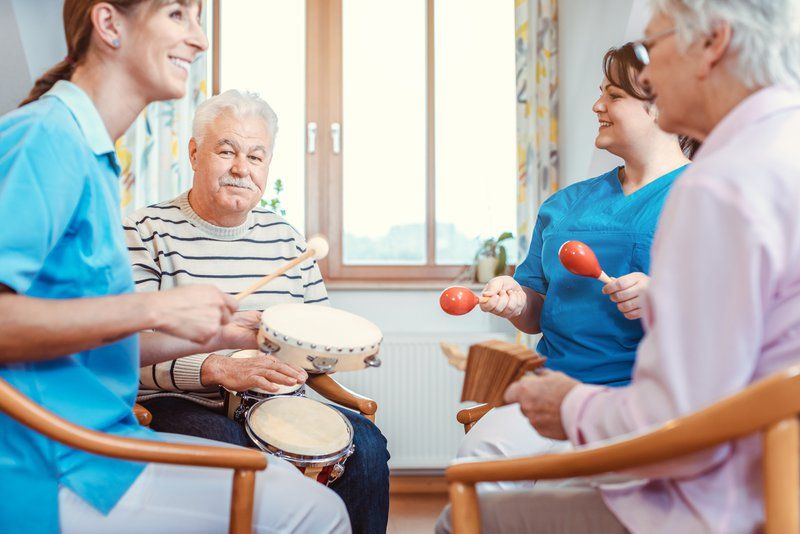BLOG
7 Creative Activities That Unlock Joy in Dementia Patients
Engaging activities play a pivotal role in enhancing the lives of individuals coping with dementia. These activities not only spark joy but also contribute to a higher quality of life. Today, we'll explore seven research-backed activities tailored specifically to stimulate the cognitive abilities of dementia patients. By incorporating these activities into daily care, caregivers can foster a sense of purpose and connection, ultimately enriching the lives of their loved ones.
Music holds a remarkable ability to unlock memories and emotions, making it a potent tool for individuals with dementia. Incorporating music into daily care routines can significantly improve the quality of life for dementia patients. Here are some effective ways to integrate music therapy into their care:

- Personalized playlists: Curate personalized playlists featuring familiar songs from the individual's past. These songs can evoke memories and emotions, providing comfort and joy.
- Live music sessions: Arrange for live music performances or musical activities within the care environment. Live music can create a sense of connection and stimulate positive emotional responses.
- Sensory experiences: Utilize music to engage the senses by incorporating instruments, rhythm sticks, or other tactile elements. This multisensory approach can enhance the overall experience and cognitive stimulation.
- Interactive sing-alongs: Encourage group sing-alongs to familiar tunes, fostering social interaction and a sense of community among residents. Singing familiar songs can bring about feelings of nostalgia and happiness.
By incorporating these music therapy techniques into the daily care of dementia patients, caregivers can tap into the profound benefits of music and its ability to positively influence emotional well-being and cognitive function.
Art Projects
Art serves as a powerful form of expression and communication, particularly for individuals facing verbal challenges due to dementia. Incorporating art projects into the care routine can provide a means for dementia patients to communicate and express themselves. Here are effective ways to utilize art for cognitive stimulation and emotional connection:
- Sensory art activities: Engage patients in tactile art activities such as finger painting, clay sculpting, or textured collage work. These activities can stimulate sensory responses and provide a non-verbal outlet for self-expression.
- Reminiscence art: Encourage the creation of art that reflects significant life events or memories. This process can facilitate storytelling and reminiscing, allowing individuals to connect with their personal history.
- Group art sessions: Organize group art sessions where patients can engage in collaborative art projects. This fosters a sense of community and shared creativity, promoting social interaction and a feeling of belonging.
- Therapeutic coloring: Provide dementia patients with coloring materials to engage in therapeutic coloring sessions. Coloring can be calming and meditative, promoting relaxation and reducing anxiety.
By integrating art projects into the care environment, caregivers can offer dementia patients a non-verbal means of expression, social engagement, and cognitive stimulation, ultimately enhancing their overall well-being.
Gardening Together
Engaging in gardening activities offers dementia patients the opportunity to connect with nature while experiencing a sense of accomplishment through nurturing living plants. Here are the benefits and effective approaches to gardening together:
- Therapeutic benefits: Gardening can be therapeutic, reducing stress and anxiety while promoting relaxation and a sense of well-being for dementia patients.
- Sensory stimulation: The tactile experience of handling soil, seeds, and plants can provide valuable sensory stimulation, engaging patients in a multisensory activity.
- Sense of purpose: Involvement in gardening activities instills a sense of purpose and responsibility, contributing to a feeling of achievement and self-worth.
- Social engagement: Group gardening activities can foster social interaction and collaboration among residents, promoting a sense of community and shared enjoyment.
By incorporating gardening into the daily routine, caregivers can provide dementia patients with a fulfilling and immersive activity that nurtures their connection to nature and offers a range of therapeutic benefits.
Memory Boxes
Memory boxes, also known as reminiscence boxes, are personalized collections of items from the past that hold significance for the individual. These boxes are designed to stimulate memory, encourage storytelling, and facilitate conversations. Here are effective ways to create and utilize memory boxes for dementia patients:
- Personalized items: Select items that hold personal significance, such as old photographs, letters, trinkets, or small mementos from the individual's life.
- Stimulating reminiscence: Encourage the individual to interact with the items in the memory box, prompting them to share stories and memories associated with each item.
- Facilitating connections: Use the memory box as a tool for connecting with caregivers, family members, and fellow residents by sharing the stories behind the items.
- Emotional engagement: The act of revisiting personal items can evoke emotions and create a sense of comfort, familiarity, and connection to one's personal history.
By incorporating memory boxes into the care environment, caregivers can provide dementia patients with a tangible and interactive means of engaging with their past, stimulating memory recall, and fostering meaningful conversations.
Cooking and Baking
Incorporating cooking and baking activities into the care routine for dementia patients can evoke memories and engage the senses, providing a multi-sensory experience that stimulates cognitive function. Here are effective ways to involve dementia patients in simple culinary tasks:
- Simple recipe preparations: Engage patients in the preparation of simple recipes that they may have enjoyed in the past, such as baking cookies or making a favorite family dish.
- Sensory engagement: Cooking and baking activities provide opportunities for sensory engagement through the touch, smell, and taste of ingredients, fostering a multi-sensory experience.
- Social interaction: Encourage group cooking sessions, where residents can work together to prepare meals, promoting social interaction and a sense of camaraderie.
- Cognitive stimulation: Following recipes and measuring ingredients can help in stimulating cognitive function, memory recall, and sequencing skills.
By involving dementia patients in cooking and baking activities, caregivers can provide them with an enjoyable and meaningful experience that taps into their sensory and cognitive abilities, ultimately contributing to their overall well-being.
Pet Therapy
Interactions with animals can bring joy, comfort, and a sense of companionship to dementia patients, making pet therapy a valuable addition to care settings. Here are considerations for introducing pets into the care environment and the benefits they can offer:

- Emotional support: Pets can provide emotional support, reduce feelings of loneliness, and offer companionship to dementia patients, contributing to their overall well-being.
- Stimulating social interaction: Interactions with pets can stimulate social interaction and communication among residents, fostering a sense of connection and engagement.
- Therapeutic effects: The presence of animals has been shown to reduce stress, anxiety, and agitation, creating a calming and comforting atmosphere for residents.
- Considerations for pet care: When introducing pet therapy, it's essential to consider factors such as allergies, pet care responsibilities, and the temperament of the animals to ensure the safety and well-being of both residents and the pets.
By incorporating pet therapy into care settings, caregivers can provide dementia patients with the opportunity to experience the many therapeutic benefits that interactions with animals can offer, enriching their daily lives.
Interactive Games
Incorporating interactive games into the daily activities of dementia patients provides an avenue for cognitive stimulation, social engagement, and enjoyable recreational experiences. Here are effective ways to introduce interactive games that enhance cognitive function:
- Memory games: Classic memory games such as matching pairs or recalling sequences can help exercise cognitive skills and memory recall.
- Word games: Engaging in word-based activities like crossword puzzles, word searches, or storytelling games can stimulate language abilities and cognitive processing.
- Puzzle activities: Completing puzzles, both traditional and digital, can support problem-solving skills and spatial reasoning, offering a mentally stimulating and enjoyable experience.
- Trivia and reminiscence games: Participating in trivia games or reminiscence activities that prompt recollection of personal experiences can foster memory recall and social interaction.
By incorporating these interactive games into the care routine, caregivers can provide dementia patients with enjoyable activities that simultaneously support cognitive function and social engagement, contributing to their overall well-being.
The incorporation of engaging activities such as music therapy, art projects, and interactive games can significantly enhance the lives of individuals living with dementia. These activities offer cognitive stimulation, emotional connection, and a sense of purpose, ultimately improving the overall quality of life for dementia patients. Caregivers are encouraged to explore these diverse activities to identify the best fit for their loved ones and witness the positive impact they can have on their well-being. For more information on holistic and compassionate care for individuals with dementia, visit https://www.assuredassistedliving.com/.
Choose the lifestyle that fits your needs
As you do your research on senior living options, keep in mind how important it is for your loved one to not only have a life filled with excellent care and support—but also a lot of fun!
We believe everyone deserves the right to quality care, in a comfortable, uplifting community setting. Let us tell you more. Download our free guide, A Family Guide to Funding Senior Care & Housing. Or contact us today.
Sources:
- Pacific Neuroscience Institute: The Unexpected Benefits of Music Therapy for Dementia Patients, According to a Geriatrician
- Art therapy for people with Dementia: Art therapy is defined by the British Association of Art Therapists as: “a form of psychotherapy that uses art media as its primary mode of communication.
- Effectiveness of Therapeutic Gardens for People with Dementia: A Systematic Review: This paper is a systematic review of quantitative studies conducted on the benefits of visiting gardens and gardening therapy for people with dementia (PWD) in an effort to assess the effectiveness of such treatments and obtain information on the most appropriate garden design for this population
- The Benefits of Pet Therapy: Nursing Made Incredibly Easy! 18(1):p 5-8, January/February2020. | DOI: 10.1097/01.NME.0000613652.69241.d7















